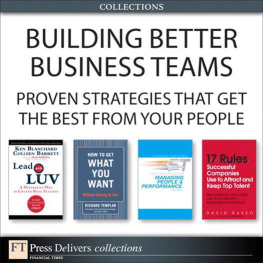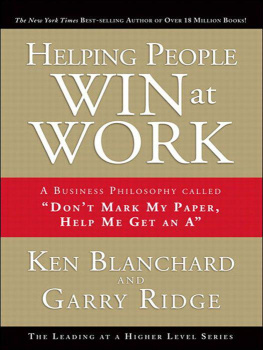In memory of
our friend and colleague
Paul Hersey
for
his genius and creativity
in the development of the original
Situational Leadership
The One Minute Managers symbola one-minute readout from the face of a digital watchis intended to remind each of us to take a minute out of our day to look into the faces of the people we lead. And to realize that they are our most importance resource.
Contents
PAUL Hersey and I began developing Situational Leadership at Ohio University in the late 1960s and then wrote about it extensively in our textbook, Management of Organizational Behavior: Utilizing Human Resources , now in its tenth edition from Prentice-Hall. In the early 1980s my coauthors, Pat and Drea Zigarmi, and I, together with the other founding associates of The Ken Blanchard Companies, made a number of changes in the model. The changes reflected our own experience, the ideas managers shared with us, and the findings of research wed been conducting. The result was a new generation of Situational Leadership thinking, which we call Situational Leadership II.
Situational Leadership IIs practical, easy-to-understand and apply approach to leading and developing people has been taught over the last thirty years to leaders at all levels of most Fortune 1000 companies, as well as to leaders in fast-growing entrepreneurial organizations throughout the world.
This new, updated edition of Leadership and the One Minute Manager reflects our latest thinking about Situational Leadership II. Written as a parable, it tells the story of an overworked entrepreneur who learns from the One Minute Manager how to get the most out of a diverse team by becoming a situational leader.
Pat, Drea, and I hope this will be a book you will read and reread until being a situational leader becomes second nature to you in your leadership roles at work, in your home, and in the community.
K EN B LANCHARD , coauthor of The One Minute Manager and Leading at a Higher Level
T HE One Minute Manager got a call one day from a woman who said she was an entrepreneur. He was glad to hear from her, because he always enjoyed talking to people who had the courage to start their own businesses.
The entrepreneur explained that she was having a hard time finding people who were willing to work as hard as she was.
I feel I have to do everything myself. I cant count on anyone to take on some of the things that need to be done, said the entrepreneur.
What you have to do, said the One Minute Manager, is learn to delegate.
But my people are not ready, said the entrepreneur.
Then you need to train them, said the One Minute Manager.
But I dont have time, said the entrepreneur.
If thats the case, said the One Minute Manager with a grin, you do have a problem. Why dont you come over this afternoon and well have a talk.
W HEN the entrepreneur arrived at the One Minute Managers office that afternoon, she found him talking to his assistant at her desk.
I appreciate your willingness to meet with me, said the entrepreneur as she joined the One Minute Manager in his office.
Its my pleasure, said the One Minute Manager. Ive heard that you have been very successful in a number of ventures. What do you think it takes to be successful?
Its really quite easy, the entrepreneur said with a smile. All you have to do is work half a day. You can work either the first twelve hours or the second twelve hours.
After hed had a good laugh, the One Minute Manager said, While I think the amount of time and effort you put into work is important, Im afraid too many people think there is a direct relationship between the amount of work they do and successthe more time they put in, the more successful they will be.
I thought you would say that, said the entrepreneur. In fact, I understand one of your favorite quotes is:
*
Dont
Work
Harder
Work
Smarter
*
Absolutely, said the One Minute Manager. But before talking about my thoughts on working smarter, let me ask you one more question.
Ask away, said the entrepreneur.
You call yourself an entrepreneur, said the One Minute Manager. What does that mean to
you?
The entrepreneur smiled and said, A friend of mine described beautifully what it means to be an entrepreneur. He told me he once took his senior vice president to the top of a hill that overlooked the city. It was a beautiful view.
He said to his vice president, Do you see that ridge down there? Wouldnt that be a great place to build a house?
It sure would be, said his vice president.
Can you imagine a pool over to the right? Wouldnt that be something? continued my friend.
Just tremendous, said the vice president.
How about a tennis court to the left? said my friend.
What a setting, said the vice president.
Let me tell you one thing, said my friend. If you continue to work as hard as you have and accomplish all the goals we have set, I guarantee that somedaysomeday, all of that will be mine.
Thats funny, said the One Minute Manager with a big smile on his face. But I think that story illustrates some of your problems with managing and motivating others.
What do you mean? asked the entrepreneur.
L ET me explain it this way, said the One Minute Manager. I would imagine your organization looks like a pyramid with you, as the CEO, at the top and all your individual contributors at the bottom. In between are several levels of management.
Thats the way its organized, said the entrepreneur. Is there something wrong with a pyramidal organization?
No, said the One Minute Manager. There is nothing wrong with it as an organizational chart. The trouble comes when you think and operate with a traditional top-down philosophy.
I dont think I follow you, said the entrepreneur.
When you think with a top-down pyramid philosophy, said the One Minute Manager, the assumption is that everyone works for the person above them on the organizational ladder. As a result, managers are thought to be responsible for planning, organizing, and evaluating everything that happens in the organization, while their people are supposed to be responsive to the directives of management. Thats why people like you end up thinking managers do all the work.
How should it be? asked the entrepreneur.
I prefer to turn the pyramid upside down, so that top managers are at the bottom, said the One Minute Manager. When that happens, there is a subtle but powerful twist in who is responsible and who should be responsive to whom.
In other words, youre saying managers should work for their people, and not the reverse.
Precisely, said the One Minute Manager. When it comes to implementation, if you think your people are responsible and that your job is to be responsive to them, you really work hard to provide them with the resources they need to accomplish the goals youve agreed to. You realize your job is not to do all the work yourself or to sit back and wait to catch them doing something wrong, but to roll up your sleeves and help them accomplish their goals. If you do that, both of you are successful.
But as I told you earlier, said the entrepreneur, I dont have time to be responsive to the needs of all my people.
You dont have to work closely with all your people, said the One Minute Manager, only those who need your direction and support to develop their competence and commitment.
You mean you treat people differently? wondered the entrepreneur.
Absolutely, said the One Minute Manager. Theres a saying we use around here that says it all:
*
Different Strokes
For
















